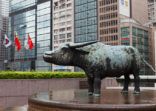Hong Kong’s Securities and Futures Commission has allowed asset managers the flexibility to offer foreign-listed ETFs to retail investors via a master-feeder structure, according to a circular from the regulator.
Under the new rules, asset managers can set-up an index-tracking ETF adopting a master-feeder structure that invests in an overseas-listed ETF (master ETF).
“Recently, the SFC has received a number of requests to allow more flexibility in the master-feeder ETF structure so that an SFC-authorised feeder ETF may invest its assets in an overseas-listed master ETF without SFC authorisation,” the regulator said.
“This would facilitate the development of ETF product line-up in a more cost-effective manner, offering more investment choices to investors.”
Other channels
Retail investors in Hong Kong, however, already have access to some foreign-listed ETFs.
For example, robo-advisers operating in the SAR, such as Aqumon, have some US-listed ETFs in their platforms.
However, Jackie Choy, Hong Kong-based director for ETF research in Asia at Morningstar, noted that robo-advisors are able to do so subject to certain conditions set by the SFC.
“The SFC has a regulation for online platforms. They may recommend non-authorised products to a particular investor given that they have done all of the appropriate procedures, such as know-your-customer and proper risk-profiling,” he told FSA.
But robo-advisors and other distributors, such as US brokerage firms that offer investors access to offshore ETFs, are not allowed to promote the products to the public.
“That is why you do not see any US-listed ETFs advertised in Hong Kong. While they can be recommended or advised to clients, they cannot be marketed,” Choy said.
With the new master-feeder ETF regulations, asset managers and distributors will be able to publicly market the feeder ETF, he said.
Cost benefits
The new regulation should also lower operational costs for ETF players in Hong Kong, especially if they have huge operations abroad, according to Choy.
“Economies of scale helps a lot and having more assets in one ETF actually help to lower costs.
“If, for example, you already have a huge ETF with low costs listed in the US, you can just set up the feeder ETF in Hong Kong. You can even charge lower fees to the investor with the feeder ETF,” he said.
However, asset managers already have the option to cross-list their ETFs in Hong Kong and have the same cost benefits, Choy said. Examples of cross-listed ETFs in Hong Kong are DWS’ Xtrackers ETFs and the SPDR Gold ETF.
“Cross-listing may be easier as you do not have to set-up another fund. But cross-listing is not always easy for all jurisdictions.”
Feeder fund regulation
The SFC has listed down certain conditions to allow the launch of master-feeder ETFs that invest in foreign-listed ETFs, according to the circular.
For example, the feeder ETF must be domiciled in Hong Kong and managed by a firm that has a Type 9 (asset management) licence with the SFC.
The foreign-listed ETF, meanwhile, needs assets of at least $1bn and a minimum track record of five years. The ETF must also adopt a physical replication of the underlying index through either a full replication or a representative sampling strategy.
The regulator added that the foreign-listed ETF must be a scheme regulated in a recognised jurisdiction managed by a firm in an acceptable inspection regime (see below), or a scheme eligible under a mutual recognition of funds arrangement.
| Recognised jurisdiction schemes | Inspection regimes |
| Australia | Australia |
| France | France |
| Germany | Germany |
| Guernsey | Ireland |
| Ireland | Hong Kong |
| Isle of Man | Luxembourg |
| Jersey | Malaysia |
| Luxembourg | Netherlands |
| Malaysia | Switzerland |
| Netherlands | Taiwan |
| Switzerland | UK |
| Taiwan | US |
| UK | |
| US |

















